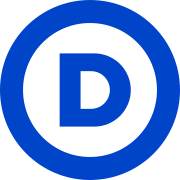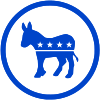The United States Democratic Party is one of the two biggest political parties in the United States. Since the mid-1850's, the party's main opponent has been the Republican Party. Both political parties have controlled American politics ever since.
Democratic Party | |
|---|---|
 | |
| Chairperson | Jaime Harrison |
| Governing body | Democratic National Committee[1][2] |
| U.S. President | Joe Biden |
| U.S. Vice President | Kamala Harris |
| Senate Majority Leader | Chuck Schumer |
| House Minority Leader | Hakeem Jeffries |
| Founders | |
| Founded | January 8, 1828[3] Baltimore, Maryland, U.S. |
| Preceded by | Democratic-Republican Party |
| Headquarters | 430 South Capitol St. SE, Washington, D.C., U.S. |
| Student wing |
|
| Youth wing | Young Democrats of America |
| Women's wing | National Federation of Democratic Women |
| LGBT wing | Stonewall Democrats |
| Overseas wing | Democrats Abroad |
| Ideology | |
| Political position | Center-left[lower-alpha 2] |
| Caucuses | Blue Dog Coalition New Democrat Coalition Congressional Progressive Caucus |
| Colors | Blue |
| Senate | 47 / 100[lower-alpha 3] |
| House of Representatives | 212 / 435 |
| State Governors | 23 / 50 |
| State upper chambers | 857 / 1,973 |
| State lower chambers | 2,425 / 5,413 |
| Territorial Governors | 4 / 5 |
| Seats in Territorial upper chambers | 31 / 97 |
| Seats in Territorial lower chambers | 9 / 91 |
| Election symbol | |
 | |
| Website | |
| democrats | |
The party sits at the centre to centre-left of the American political spectrum, with the Republican Party being positioned to their right.
Every four years the party holds a National Convention where they agree on their candidate for president. The Democratic National Committee coordinates most of the activities of the Democratic Party in all 50 United States. Since Andrew Jackson's inauguration in 1829, there have been 16 Democratic presidents. The most recent and current is Joe Biden who took office as the 46th president of the United States in January 2021.
The Democratic Party represents a broad spectrum of liberal and left-wing ideologies,including but not limited toclassical liberalism, social democracy, progressivism, and social modern liberalism.
Philosophy and role in government
Democrats, also sometimes called the left, liberals or progressives make up one of the two main political parties in the United States. A mostly Democratic state is sometimes called a blue state. This comes from the party’s main color, which is blue, referring to a state supporting ‘blue’ candidates.
Democrats believe in a strong government with social assistance programs to help members of society. They prefer diplomatic solutions to conflicts, and take generally multilateralist views on trade, believing that trade must be free, but fair to protect American workers, consumers, local communities, and the environment. Some Democrats are economic centrists.[14][15]
Socially, most Democrats believe in sociocultural liberalism, taking pro-immigration, pro-marriage equality, and pro-choice views.[16][17][18][19]
Philosophy and role in government
Democrats, also sometimes called the left, liberals or progressives make up one of the two main political parties in the United States. A mostly Democratic state is sometimes called a blue state. This comes from the party’s main color, which is blue, referring to a state supporting ‘blue’ candidates.
Democrats believe in a strong government with social assistance programs to help members of society. They prefer diplomatic solutions to conflicts, and take generally multilateralist views on trade, believing that trade must be free, but fair to protect American workers, consumers, local communities, and the environment. Some Democrats are economic centrists.[20][21]
Socially, most Democrats believe in sociocultural liberalism, taking pro-immigration, pro-marriage equality, and pro-choice views.[22][23][24][25]
Democratic Beliefs
Currently, the Democratic Party is identified by progressivism, liberalism, and left-wing policies.
Not all Democrats believe in the same thing, but generally these are the things many Democrats support:
- Progressive income tax.
- Higher corporate taxes and recapturing income from overseas profits.
- Spending on business, education, infrastructure, clean-energy.
- Expanding spending on government programs.
- Ending the death penalty.
- Expanding rights to Abortion.
- Gun regulations to prevent citizens from hurting themselves and others with firearms.
- Support Same-sex marriage.
- Universal healthcare.
- Declare Washington D.C. an official state.
- Helping students go to college or university for free without having to pay back the government.
- Allow undocumented immigrants in the U.S. to stay, pay taxes, and oppose mass deportation.
Most support for Democrats comes from states in the Northeast, Upper Midwest, and the Pacific Coast, as well as from the state of Hawaii.
Symbols
The symbol of the Democratic Party is the donkey.[26] Since the election of 2000, the color blue has become a symbol for Democrats.[27]
Historically, Thomas Jefferson, whom the party claims as its founder, has been often seen as symbols of the Democratic Party, particularly emphasized in the annual celebrations of Jefferson Day Dinners held since the days of Andrew Jackson. As such, the Democratic Party is also often referred to as the “Party of Jefferson.”[28]
List of democratic presidents
List of famous Democratic politicians
- Kamala Harris (California), Vice President and U.S. Senator from California
- John Kerry (Massachusetts), former Secretary of State, former Senator, former presidential nominee
- Patrick Leahy (Vermont), former President Pro Tempore, Senator, and Dean of the Senate
- Hillary Clinton (New York), former Secretary of State, former Senator, former First Lady, former presidential nominee
- Jim Clyburn (South Carolina), Representative and Assistant Democratic Leader
- Howard Dean (Vermont), former Governor and former head of the Democratic National Committee, former presidential nominee
- Christopher Dodd (Connecticut), former Senator
- Mario Cuomo (New York), former Governor
- Dick Durbin (Illinois), Senate Whip
- George Moscone (California), former Mayor of San Francisco
- Chuck Schumer (New York), Senator, former Senate Majority Leader
- Harvey Milk (California), Member of the San Francisco Board of Supervisors
- William M. Daley (Illinois), candidate for Governor of Illinois, former White House Chief of Staff
- Frank Lautenberg (New Jersey), former Senator
- Pat Quinn, Governor of Illinois
- Paul Simon (Illinois), former Senator
- Arlen Specter (Pennsylvania), former Senator
- Bob Menendez (New Jersey), Senator
- Richard M. Daley (Illinois), former Mayor of Chicago
- Richard J. Daley (Illinois), former Mayor of Chicago
- Al Gore (Tennessee), former presidential candidate and vice-president
- John F. Kennedy, former President (Massachusetts)
- Robert F. Kennedy, former Senator, former presidential candidate, and brother of John F. Kennedy
- Daniel Inouye (Hawaii), former President Pro Tempore, former Senator, and former Dean of the Senate
- Steny Hoyer (Maryland), House Minority Whip
- Robert Byrd (West Virginia), former President Pro Tempore, former Senator, and former Dean of the Senate
- Tim Kaine (Virginia), Governor, 2016 vice presidential nominee and former head of the Democratic National Committee
- Dennis Kucinich (Ohio), Representative
- Janet Napolitano (Arizona), Secretary of Homeland Security
- Nancy Pelosi (California), Speaker of the House, former Speaker of the House.
- Brian Schweitzer (Montana), former Governor
- Harry Reid (Nevada), former Senate Minority Leader, former Majority Leader
- Rahm Emanuel (Illinois), Mayor of Chicago, former White House Chief of Staff
- Harry F. Byrd, Jr. (Virginia), former Senator
- Bill Richardson (New Mexico), Governor
- Debbie Wasserman Schultz (Florida), Representative and former head of the Democratic National Committee
- Mark Warner (Virginia), Senator and former Governor
- Elizabeth Warren, Senator from Massachusetts
- Alexandria Ocasio-Cortez (New York), Representative
- Hakeem Jeffries, House Minority Leader
Independents who caucus with Democrats
- Bernie Sanders, Senator from Vermont
- Angus King, Senator from Maine
- Kyrsten Sinema, Senator from Arizona
- Joe Manchin, Senator from West Virginia
List of former Democrats

- Ronald Reagan (California), 40th president of the United States (1981–1989). Registered Democrat until 1962.
- Condoleezza Rice (Alabama), 66th United States Secretary of State (2005–2009). Registered Democrat until 1982.
- Rudy Giuliani (New York), 107th Mayor of New York City (1994–2001). Registered Democrat until 1975.
- Rick Perry (Texas), 14th United States Secretary of Energy (2017–2019), 47th Governor of Texas (2000–2015). Registered Democrat until 1989.
- Jesse Helms (North Carolina), United States Senator (1973–2003). Registered Democrat (1942–1970).
- Donald Trump (New York), 45th President of the United States (2017–2021), Registered Democrat on and off until 2009.[29]
Related pages
References
Other websites
Wikiwand in your browser!
Seamless Wikipedia browsing. On steroids.
Every time you click a link to Wikipedia, Wiktionary or Wikiquote in your browser's search results, it will show the modern Wikiwand interface.
Wikiwand extension is a five stars, simple, with minimum permission required to keep your browsing private, safe and transparent.
















